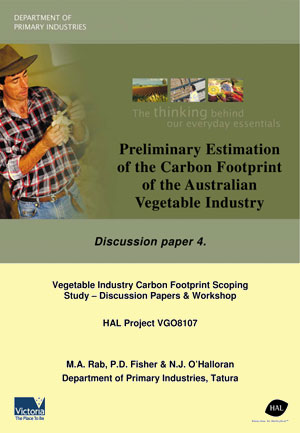|
|
The Australian vegetable industry is interested in identifying its carbon footprint. The aim of this discussion paper is to review :
Summary : This report has undertaken a preliminary carbon footprint analysis for the Australian vegetable industry based on readily available data. It discusses the data needs for developing a carbon footprint analysis and discusses the current availability of suitable data. It has been written as part of a series of six discussion papers for a workshop that will set future directions for R, D & E on greenhouse gas emissions from the vegetable industry. Accounting for greenhouse gas (GHG) emissions is fast becoming an imperative for the horticulture industry. The rise in Government interest in emissions mitigation, the potential for industry involvement in emissions trading schemes, and the community awareness of the impact of GHG emissions, all provide an opportunity for the Australian vegetable industry to be able to:
The Australian vegetable industry is interested in identifying its carbon footprint in response to these external pressures. The work for this paper has illustrated that it in many cases data on GHG emissions factors suitable for the vegetable industry, or even data on industry practices, are not readily available. The consequence of this is that it has not been possible to even make a first approximation of the GHG emissions occurring from some components of the Australian vegetable industry’s carbon footprint. In this paper we have focused on what are thought to be the largest industry related emissions including:
Using the best readily available data, a preliminary estimation of the total emissions form these sources is 1,047,008 t CO2-e yr-1, which is approximately one-third the value of other estimates. However, this value should be used with considerable caution and only after the assumption underlying this figure are understood. Acknowledgments : Funding was provided by Australian vegetable growers (through the R & D levy) and Horticulture Australia Limited. The Australian Government provides matched funding for all HAL’s R&D activities. |
||||||
|

